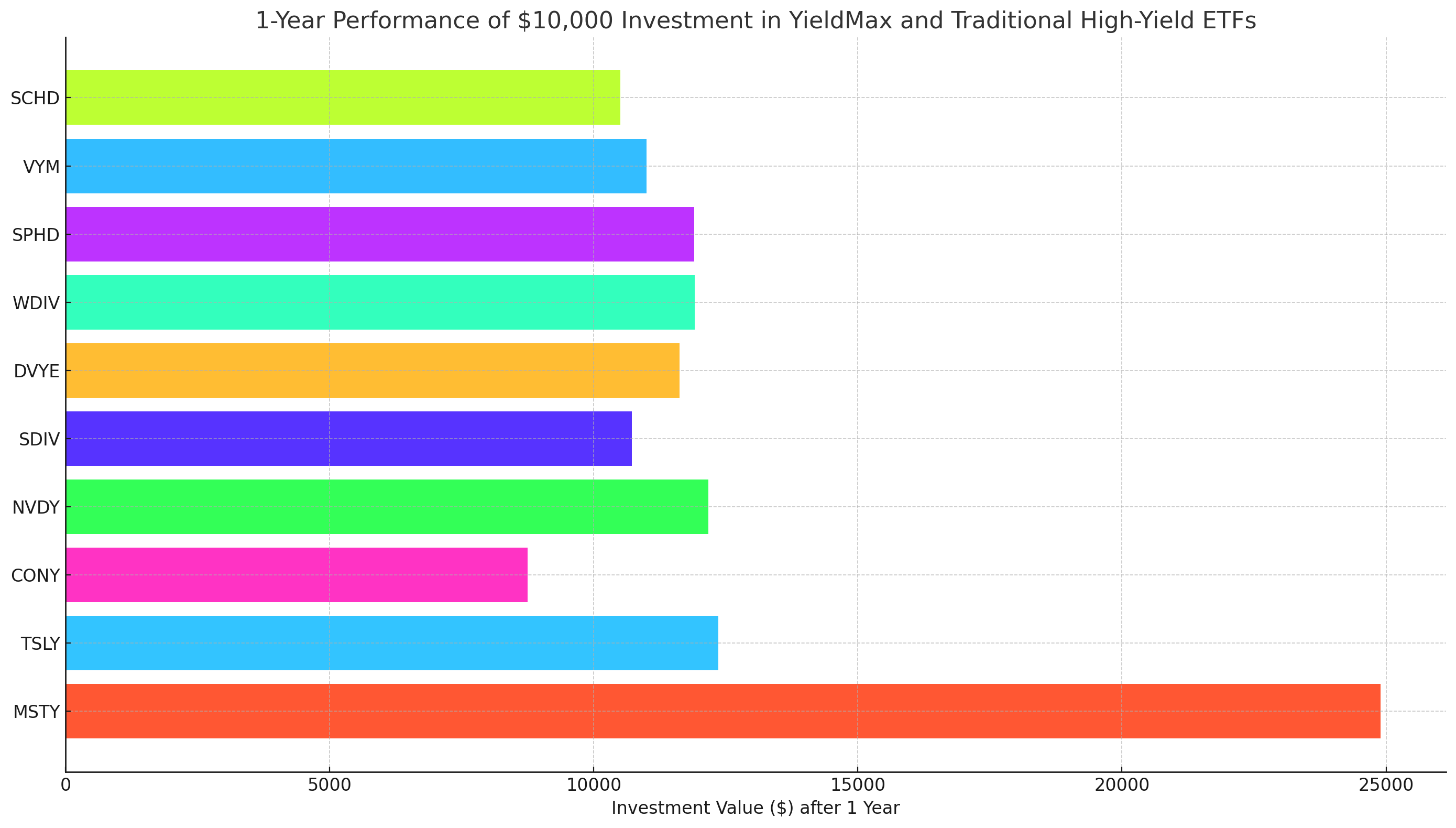The Market is down and yields are up.
Lots of people flip to assured revenue when the markets are risky or transferring sideways. A preferred alternative is Schwab’s SCHD etf, but when we take revenue investing to the intense we discover corporations like Yield Max which can be excessive threat excessive revenue machines. Some funds are boasting distribution charges exceeding 100%, it’s no shock they’ve attracted yield-hungry buyers in search of to maximize returns in a risky market. Nonetheless, these sky-excessive payouts come with a caveat: potential NAV erosion, elevated threat, and a cap on upside potential.
The YieldMax suite consists of ETFs like the MSTR Possibility Revenue Technique ETF (MSTY), TSLA Possibility Revenue Technique ETF (TSLY), COIN Possibility Revenue Technique ETF (CONY), and NVDA Possibility Revenue Technique ETF (NVDY). These funds generate revenue by promoting lined name choices on single shares, successfully buying and selling away potential upside in alternate for money premiums.
Amongst them, MSTY has delivered the most staggering returns. A $10,000 funding in MSTY one yr in the past would now be value $24,891 — a 148.91% complete return fueled by Bitcoin’s rebound and MicroStrategy’s leveraged publicity. But, such dramatic features spotlight the speculative nature of these ETFs. TSLY and NVDY additionally carried out nicely, turning $10,000 into $12,355 and $12,169 respectively. In distinction, CONY’s Coinbase publicity dragged it down, leaving a $10,000 funding value simply $8,753.
Whereas these returns are eye-catching, they underscore the inherent threat of YieldMax ETFs. Lined name methods cap potential features, and reliance on risky property like Bitcoin and Coinbase exposes buyers to important value swings. Moreover, NAV erosion is a actual concern. A constant payout of over 100% yearly is unlikely to be sustainable long-time period, particularly if the underlying shares underperform.
Funding Simulation: $10,000 Invested in YieldMax ETFs and Conventional ETFs
To illustrate the threat/reward profile, the chart under consolidates the efficiency of $10,000 investments in each YieldMax ETFs and conventional high-yield ETFs over the previous yr.
The information reveals a putting distinction between the speculative nature of YieldMax ETFs and the steadier returns of extra typical high-yield funds.
MSTY emerges as the high performer with a 148.91% return, pushed by MicroStrategy’s aggressive Bitcoin acquisition technique.
TSLY and NVDY additionally generated strong returns, although far under MSTY’s outsized features.
CONY, nevertheless, serves as a cautionary story, dropping over 12% due to Coinbase’s inventory efficiency.
On the different hand, conventional ETFs like SPHD and WDIV supplied extra steady returns of round 19%, whereas SCHD and VYM offered average, lower-threat features.
Conventional Excessive-Yield ETFs: Revenue with Stability
For income-in search of buyers unwilling to settle for the threat profile of YieldMax ETFs, extra conventional high-yield ETFs current a compelling different. Funds like the Schwab U.S. Dividend Fairness ETF (SCHD), Vanguard Excessive Dividend Yield ETF (VYM), and SPDR S&P World Dividend ETF (WDIV) supply decrease however extra steady yields.
SCHD, for occasion, combines a 3.99% dividend yield with a focus on high quality U.S. dividend-paying shares. Its one-yr complete return of 5.06% is modest however displays a extra balanced method between revenue and development. VYM, one other dependable dividend play, has delivered a 10.03% complete return over the previous yr.
Extra aggressive choices embrace SDIV and DVYE, which yield 11% and 11.36% respectively. These funds goal high-yielding world shares, however with elevated publicity to rising markets, they carry greater volatility. In the meantime, SPHD and WDIV have supplied sturdy returns, with SPHD gaining 19.06% and WDIV up 19.14% over the previous yr.
Consolidated Efficiency Evaluation

To present a broader context, right here’s how a $10,000 funding in every fund would have carried out over the previous yr:
MSTY: $24,891 — 148.91% return
TSLY: $12,355 — 23.55% return
CONY: $8,753 — –12.47% return
NVDY: $12,169 — 21.69% return
SDIV: $10,725 — 7.25% return
DVYE: $11,628 — 16.28% return
WDIV: $11,914 — 19.14% return
SPHD: $11,906 — 19.06% return
VYM: $11,003 — 10.03% return
SCHD: $10,506 — 5.06% return
Conventional high-yield ETFs present extra stability and much less excessive swings in worth. Whereas they lack the outsized returns of MSTY or TSLY, they additionally keep away from the dramatic losses seen in CONY. This steadiness can be essential for revenue buyers centered on preserving capital whereas producing constant money circulate.
Weighing Dangers and Alternatives
YieldMax ETFs current an intriguing but speculative method to revenue investing. Their triple-digit yields are onerous to ignore, however the dangers — NAV erosion, capped upside, and publicity to risky property — are equally pronounced. MSTY and TSLY are clear winners for aggressive buyers betting on Bitcoin and Tesla, whereas NVDY presents a center floor with NVIDIA publicity. Nonetheless, CONY’s decline serves as a cautionary story for these investing in high-threat sectors.
In the meantime, conventional ETFs like SCHD, VYM, and SPHD supply extra predictable returns, albeit with decrease yields. DVYE and SDIV cater to these in search of greater revenue however come with elevated rising market threat. For conservative buyers, SCHD stays a standout for its steadiness of high quality holdings, revenue technology, and comparatively low volatility.
Closing Takeaway: Balancing Revenue and Threat
The alternative between YieldMax ETFs and conventional high-yield funds finally comes down to an investor’s threat tolerance. These in search of outsized revenue potential and keen to abdomen important volatility could discover worth in MSTY and TSLY. Nonetheless, for extra conservative revenue methods, SCHD, VYM, and SPHD present a safer path with much less draw back threat.






